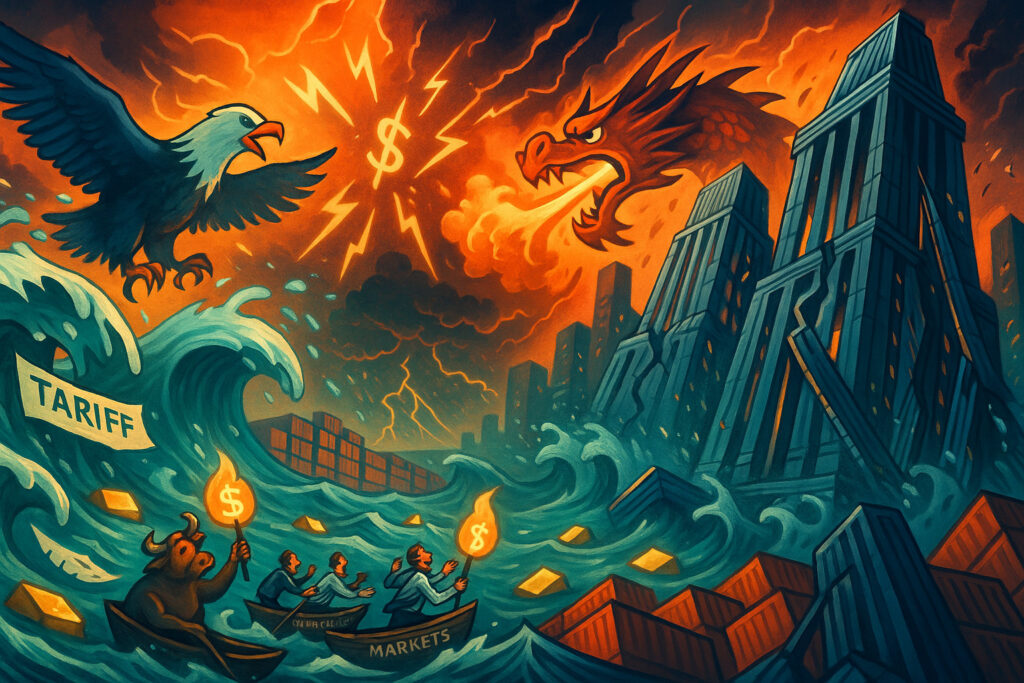Introduction
On 11 October 2025, markets across the globe reeled under a renewed wave of trade escalation. The previous day’s announcement by President Trump — imposing 100% tariffs on key Chinese imports and expanding export controls — jolted confidence, sending equities sharply lower and prompting a flight into safe havens. As the U.S. dollar weakened, gold surged anew. In the absence of fresh economic data due to the ongoing shutdown, investors turned to policy signals, capital flows, and trade diplomacy for cues. This was a day when optimism faced its harshest adversary: geopolitical volatility.
Markets woke to an urgent question: can the current rally survive a trade war revival, or is it now riding on borrowed momentum?
Body
The Trade Shock That Imperiled Euphoria
The catalyst was abrupt and severe: a broad-based U.S. tariff escalation targeting Chinese goods, coupled with export controls on critical software. The measures were framed as retaliation against China’s restrictions on rare-earth exports, but markets saw deeper risk — the unraveling of fragile stability in U.S.–China relations.
Across trading floors, traders scrambled. The S&P 500 plunged by more than 2.5%, the Nasdaq dropped nearly 3.5%, and the Dow Jones fell by over 800 points. This marked one of the sharpest intraday moves in months, erasing the gains of recent weeks.
The reaction was global. European indices ceded ground, Asian markets fell amid fresh concerns, and commodity prices tumbled. Risk assets were under siege.
Gold Lights the Sky as Dollars Slip
As equities sold off, gold once again became the frontline beneficiary. Spot prices broke above $4,050/oz, reclaiming ground and reinforcing its role as the marquee safe-haven. The metal’s surge reflected an investor cohort fleeing uncertainty, debt, and policy erraticism.
The U.S. dollar index weakened in tandem, pressured by panic flows. Other currencies edged higher in relief trades. The currency realignment added fuel to emerging markets and commodities.
Bond Yields, Credit Stress & Curve Dynamics
In U.S. Treasuries, yields plunged. The 10-year yield dropped sharply, while the short end held steadier, steepening the yield curve. Credit spreads widened, particularly in corporate and high-yield sectors. The move signaled that capital was rushing to safety segments.
Markets swiftly repriced Fed rate expectations: while a cut in October remained probable, the magnitude and timing became more tentative. Many speculators began to question whether central bankers would lean toward caution in the face of trade turbulence.
Sector Reactions: Winners, Losers, and Survivors
The selloff was not evenly distributed:
- Technology / AI / Semiconductors: among the hardest hit. Many of these stocks carry sensitivity to Chinese demand and supply chain exposure, and they bore the brunt of the retreat.
- Global exporters / industrials: also under pressure, as trade linkages with China reversed from tailwind to headwind.
- Gold / mining equities: surged sharply, with miners outperforming many major sectors.
- Defensives (utilities, health, staples): drew safe inflows, mitigating losses from growthier names.
- Financials: uneven — banks and insurers saw losses tied to credit risk and yield shifts, but some firms with lower exposure held up.
- Energy / commodities: commodity prices fell as demand fears flared. Energy stocks were dragged lower amid global growth concerns.
Rotation in the day pointed decisively away from risk and toward safety. Growth leadership reversed partially, and caution reigned.
Global Response: Asia, Europe, and Emerging Markets
Asia responded with steep declines. The Hang Seng fell over 2%, while other regional markets followed suit. Chinese technology stocks were especially battered, reflecting direct exposure to the tariff blowback.
Europe fared similarly. German, French, and UK equity indices lost ground, weighed down by export risks. The euro slipped, and broader sentiment soured.
Emerging markets moved in both directions: commodity exporters saw mild relief, while those reliant on exports to China or open trade regimes suffered. Currency volatility increased in many regions.
Sentiment & Positioning: Fear Finally Enters the Room
The shock triggered a jolt in positioning. Many momentum and growth funds were forced to unwind positions. Hedging costs soared. Implied volatility spiked across equity, FX, and commodity markets. Options markets displayed asymmetric skew, as downside protection became premium.
Investors gravitated to gold, cash, and ultra-safe bond durations. The prior narrative of “liquidity-led growth” looked brittle under the weight of trade risk.
Markets no longer trusted assumptions; they began demanding proof.
Conclusion
11 October 2025 will be remembered as the day the trade storm returned. Euphoria cracked as equities collapsed, gold soared above $4,050, and global markets shook under the weight of retaliation fears. The rally that had seemed unstoppable now faces one of its sternest tests.
Key Questions Ahead
- Can markets stabilize if diplomatic talks revive, or will volatility persist?
- Is this the start of a broader de-risking phase, or a severe but manageable correction?
- How will the Fed respond if growth weakens amid these trade pressures?
- Will gold maintain dominance amid heightened volatility, or will capital rotate back into equities under relief?
- Does this crisis force investors to reassess the durability of the narrative that fueled the rally?
Markets have entered a storm. October 11 may go down as the day risk reasserted itself — and confidence had to fight for each point of ground.
